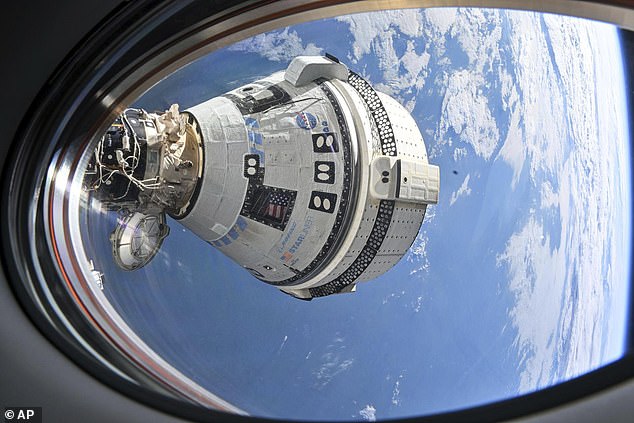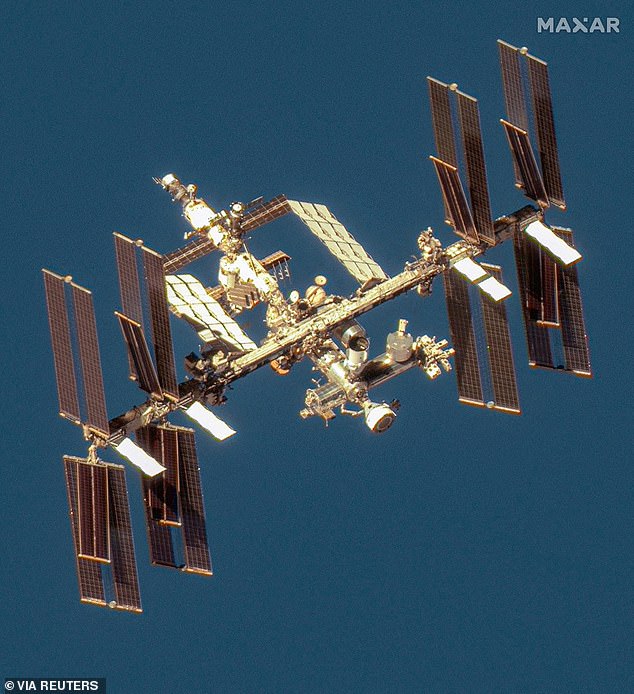Astronauts trapped in space by Boeing’s faulty Starliner are given horrifying news about potential return to Earth
NASA astronauts stranded by Boeing’s malfunctioning Starliner received chilling news Wednesday about their return mission to Earth.
Suni Williams and Butch Wilmore, who have been stuck on the International Space Station (ISS) for more than two months, may not return to Earth until February 2025.
The US space agency announced a contingency plan that would send a two-person crew on SpaceX’s Crew-9 mission in September and bring the crew home months later.
The announcement is another embarrassing setback for Boeing, which has been struggling with a series of problems with its commercial aircraft.
For weeks, NASA touted the idea that the capsule was safe enough to return Suni Williams and Butch Wilmore from the International Space Station (ISS), despite the craft suffering from leaks and thruster problems.
Tuesday marks 60 days since the Starliner crew was in space, compared to an original schedule of just eight days.
Due to failures in the Starliner’s thrusters and helium leaks, NASA and Boeing decided to keep the two astronauts in space longer. They feared that a return trip with the spacecraft could be disastrous.
During this time, the teams conducted tests to determine whether the capsule could fly.
Boeing said last week that it “remains confident in the Starliner spacecraft and its ability to safely return crew.”
However, experts told DailyMail.com in June that NASA could be forced to launch a rescue mission, suggesting Elon Musk’s SpaceX could be called in to help.
Mike Gruntman, an astronautics professor at the University of Southern California, told DailyMail.com that “it is more likely that SpaceX will be able to conduct an additional launch in the near future to bring the astronauts back.”
“It is deeply unfortunate that Boeing’s Starliner, after so many flight delays, is still experiencing problems,” Gruntman said.
“Boeing was one of the most admired aerospace and defense companies for decades. This is a true national tragedy.”
Problems with Boeing’s commercial jets, including turbulence, mechanical issues and tail buffeting, have cost the company at least $3 billion.
And NASA awarded Boeing a $4.2 billion contract to build the Starliner, an astronaut taxi to the ISS.
A meeting this week of NASA’s Commercial Crew Program, which oversees Starliner, ended with a disagreement among some officials over a plan to accept Boeing’s test data and use Starliner to bring the astronauts home.

The crew’s return mission has been delayed several times since launch in June due to leaks and thruster problems during the journey to the International Space Station (ISS).
“We didn’t conduct the surveys in a way that led to any conclusions,” said Steve Stich, head of the Commercial Crew Program.
“We heard from a lot of people expressing concerns, but the decision wasn’t clear,” added Ken Bowersox, NASA’s chief space officer.
While no decision has been made on whether to deploy SpaceX’s Starliner or Crew Dragon, NASA has given Boeing more time to conduct more tests and collect more data to better demonstrate Starliner’s reliability.
Officials said NASA expects to make a decision sometime next week.
Boeing’s tests so far have shown that four of the Starliner jets failed in June because they overheated and automatically shut down. Other boosters that were reactivated during the tests were weaker than normal because of a restriction in their fuel.
Ground tests in late July at the White Sands Missile Range in New Mexico showed that overheating of the thrusters causes a Teflon seal to warp, clogging the fuel tubes for the thrusters and reducing their thrust.

Tuesday marked 60 days since the Starliner crew was in space, compared to an original plan of just eight days.
“That, I think, has added to the discomfort and the lack of full understanding of the physical laws of what’s happening,” Stich said, explaining why NASA now seems more willing to discuss a Crew Dragon event, after previously downplaying such a prospect to reporters.
Starliner lifted off from Cape Canaveral Space Force Station in Florida at 10:52 a.m. ET on June 5 due to a leak that required a cleanup operation in May.
The teams discovered a helium leak at a valve and canceled the mission.
Engineers suspected the problem was caused by a faulty rubber seal the size of a shirt button. They said that even if the leak got worse, it could be fixed during the flight. The next launch was scheduled for June 1.
However, Starliner suffered another setback when the capsule was automatically stopped by a computer-controlled system just minutes before launch.
The delay was caused by computers on the Atlas V rocket’s launch pad coordinating the final moments before launch, but the Starliner capsule appeared healthy, officials said.
The issue raised concerns among a NASA contractor, who urged the US space agency to “re-run safety checks and re-examine safety protocols to ensure the Starliner is safe before something catastrophic happens.”
Erin Faville, president of ValveTech, expressed her concerns about the June 6 launch, telling DailyMail.com: “I warned. I choose to let it happen.”
Starliner suffered five failures in its 28 thrusters, five leaks of helium gas used to pressurize the thrusters, and a slow-moving fuel valve that indicated unresolved problems since launch.
When Starliner arrived near the space station for docking on June 6, five thruster failures prevented the spacecraft from approaching the station until Boeing fixed the problem.
Boeing has been testing thrusters on the ground and in space in recent weeks to determine why five thrusters failed just before Starliner arrived at the space station.
All but one came back online. Helium leaks in the capsule’s propulsion system were also discovered.
